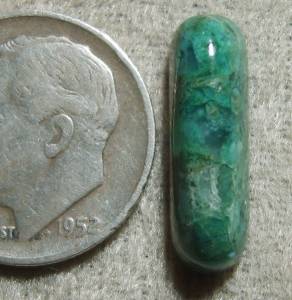Chrysocolla is a sky-blue to greenish blue and green
color, often streaked with black. It is found in the oxidization zone of copper deposits and associated with azurite, malachite,
cuprite, turquoise, and quartz (chalcedony mostly). Chrysocolla is considered an ore of copper when associated with other
secondary copper minerals. It is rarely found in its pure form, being free of quartz, and is likely to crack as it loses water
in a dry home environment.
Chrysocolla is microcrystalline in structure and usually
found in solid vein-filling or botryoidal masses or crusts, often opal-like in appearance. It has a light translucent look
with a vitreous to glassy luster. It is fragile and brittle with a hardness of 2–4 and exhibits a conchoidal fracture.
Chrysocolla is found in Chile, Mexico, Russia, Africa,
England, Italy, and in the U.S. in Colorado, Arizona, Nevada and New Mexico. Its only value is as a semi-precious gemstone
in jewelry. The high quality material is highly prized and sought after by jewelers and rough specimen collectors alike.
